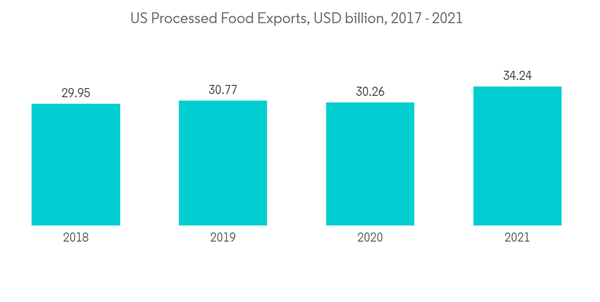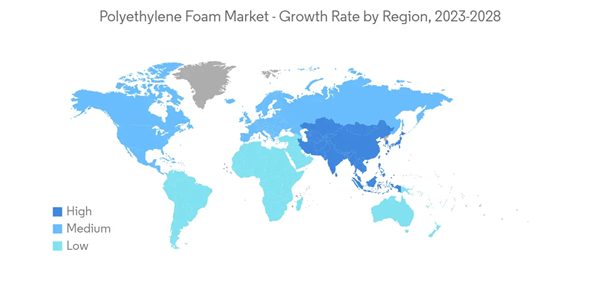During the time frame of the forecast, the polyethylene foam market is expected to grow at a CAGR of more than 3%.
Demand for protective packaging, thermal insulation, and cushioning solutions drove growth in the polyethylene foam market during the COVID-19 pandemic. The emergence of e-commerce and subsequent online delivery necessitated more robust packing options, fueling the expansion of the polyethylene foam industry. During the pandemic, there was also an uptick in the need for products that provide thermal insulation and cushioning for hospital equipment and supplies. In general, the polyethylene foam industry benefited from the COVID-19 epidemic.
This product will be delivered within 2 business days.
Demand for protective packaging, thermal insulation, and cushioning solutions drove growth in the polyethylene foam market during the COVID-19 pandemic. The emergence of e-commerce and subsequent online delivery necessitated more robust packing options, fueling the expansion of the polyethylene foam industry. During the pandemic, there was also an uptick in the need for products that provide thermal insulation and cushioning for hospital equipment and supplies. In general, the polyethylene foam industry benefited from the COVID-19 epidemic.
Key Highlights
- The market is growing because people are using it more and more for packaging, which needs it because it can take a lot of hits.
- On the other hand, unfavorable conditions caused by the COVID-19 outbreak slowed market growth during the forecast period.
- Packaging applications are anticipated to dominate the polyethylene foam market due to its excellent properties, such as its lightweight nature, resistance to moisture and heat, frost protection, and shock and vibration absorbance.
- Due to the high demand from different industries in the region, the polyethylene foam market is expected to be biggest in Asia-Pacific.
Polyethylene Foam Market Trends
High Demand of Polyethylene Foam in Packaging Application
- Polyethylene foam is widely used in the application of packaging.It is a versatile, closed-cell type of foam whose structure is made up of minor air pockets. Its properties, such as its lightweight nature, heat insulation, and incredible shock and vibration resistance, make it suitable for packaging purposes.
- Furthermore, it provides great resistance to weather and oil and can be used for carrying different kinds of goods that are susceptible to weathering and oil-related threats. Few of these foams also comply with FDA food contact regulations.
- Polyethylene foam is often used to preserve the freshness and quality of processed food that is exported. Foam is a lightweight and durable substance that keeps food undamaged and fresh for longer. Polyethylene foam is widely used as a cushioning material in shipping containers and for food product packaging.
- According to the United States Department of Agriculture (USDA), in 2021, exports of processed foods from the United States totaled 34.24 billion dollars, up 13% from the previous year. Furthermore, exports of prepared foods from the United States totaled 13.88 billion dollars, up 11% from the previous year.
- As a result, all of the above factors are expected to drive polyethylene foam demand from the packaging application during the forecast period.
Asia-Pacific to Dominate Polyethylene Foam Market
- Asia-Pacific has a big share of the global polyethylene foam market, which is expected to grow over the next few years.
- Asia-Pacific accounted for a major chunk of global construction spending. In the construction industry, polyethylene foam is used for pipe-in-pipe, doors, roofing sheets, and slabs. The building sector makes extensive use of its qualities, which include high levels of thermal insulation, resistance to frost, and pliability.
- Polyethylene foam is commonly used for cushioning and padding in furniture. It's widely used because of its reliability, affordability, and portability. It is possible to mold and densify polyethylene foam for use in the furniture industry. It can be used to soften the feel of chair and couch seats, armrests, and backs. It's also used in pillowcases and mattress pads. China will have earned more than USD 70 billion from furniture exports by 2021.
- Packaging materials for medical gadgets often consist of polyethylene foam. Shipping and storing equipment are easier knowing that they are protected by foam. Polyethylene foam is a good choice for packing medical supplies since it is lightweight, cushiony, and shock-absorbing. Medical equipment of the highest precision needs to be shielded by the soft, flexible foam.
- India is one of the leading nations for medical equipment manufacturing. Exports of medical devices from India have expanded greatly over the years. According to the India Brand Equity Foundation, in 2021, medical device exports from India were valued at USD 2.53 billion and were expected to surpass USD 10 billion by 2025.
- Pharmaceuticals are often packaged in polyethylene foam since it is non-toxic and latex-free. The pharmaceutical market in Asia Pacific is likely to be led by countries like Japan, China, and South Korea, with China and Japan collectively accounting for more than 15% of the global pharmaceutical market.
- So, because of the above factors, the Asia-Pacific polyethylene foam market is expected to grow a lot over the next few years.
Polyethylene Foam Market Competitor Analysis
The polyethylene foam market is partially consolidated. Some of the players in the market are PAR Group, Sealed Air, Zotefoams PLC, Thermotec, and DAFA US Inc.Additional benefits of purchasing the report:
- The market estimate (ME) sheet in Excel format
- 3 months of analyst support
This product will be delivered within 2 business days.
Table of Contents
1 INTRODUCTION
4 MARKET DYNAMICS
5 MARKET SEGMENTATION
6 COMPETITIVE LANDSCAPE
Companies Mentioned (Partial List)
A selection of companies mentioned in this report includes, but is not limited to:
- Armacell
- DAFA US Inc.
- Hira Industries LLC
- JSP
- PAR Group
- Pregis LLC
- Sealed Air
- Thermotec
- Wisconsin Foam Products
- Zotefoams PLC
Methodology

LOADING...










